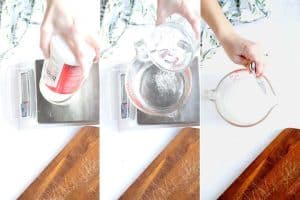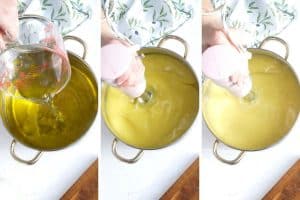Olive Oil Castile Soap Recipe
A pure and simple olive oil soap recipe. Easy to make.
Equipment
- 10-inch soap mold
Ingredients
- 9.5 ounces water
- 3.82 ounces lye
- 30 ounces olive oil
- 2 tablespoons orange essential oil (optional for fragrance)
- 0.6 ounces sodium lactate (optional, creates a firmer bar)
Instructions
- Prepare your workspace. Before starting the soap-making process, take all necessary safety precautions. Put on your safety goggles, gloves, and long sleeves. Make sure your workspace is well-ventilated and free from any distractions like pets or children.
- Combine the lye and water. In separate, non-reactive containers, measure out the lye and water. Slowly add the lye to the water (never the other way around), stirring until the lye dissolves completely. Set aside in a safe, well-ventilated place and allow the lye water to cool to 100-115°F (38-46°C). While the lye solution cools, proceed to the next step.

- Warm the olive oil. Add all the olive oil to a large, non-reactive saucepan. Gently heat over medium-low heat until the oil reaches 130-140°F (54-60°C). Once heated, set the oil aside to cool to 100-115°F (38-46°C). This may take an additional hour or so. Tip: If your olive oil cools faster than the lye water, you can gently reheat the oil to bring it back within the desired temperature range. Avoid reheating the lye water.

- Prepare for blending. Before combining the lye solution with the oil, prepare your soap mold and have any optional fragrance (like orange essential oil) and color ready to go. If you use sodium lactate, add it to the cooled lye water just before mixing.
- Combine the lye solution with the oil. Pour the lye water into the pot with the olive oil. Using a stick blender, blend the mixture until "trace" is reached. Trace is when the soap batter thickens, and you can drizzle it on top of itself, leaving a trail that stays on the surface for a moment before sinking back in. This stage may take at least five minutes of blending. The mixture should resemble a thin pudding.

- Pour soap into the mold. Immediately pour the soap batter into the prepared soap mold. Smooth the top with a spatula if needed. Allow the soap to cure in the mold for 24-48 hours at room temperature.

- Unmold and cut into bars: Carefully turn the soap out of the mold. Cut the soap into bars using a sharp knife. Place the bars on breathable fabric or wire racks in a cool, dry, well-ventilated space to cure for at least four weeks. Curing allows the soap to harden and any remaining moisture to evaporate, resulting in a longer-lasting bar. Turn the bars occasionally to ensure even curing.

Notes
This soap recipe is different from most because it starts off very soft but becomes very hard as it cures. It can be tricky to know when to cut it into bars because of this. It's best to pour this soap into individual molds so you don't have to worry about it getting too hard to cut.
You should use 3.98 ounces of lye for this cleaning soap, with a 2% superfat content, which is calculated at 6% lye.
After pouring the soap into the mold, you can lightly cover it with a towel or blanket to keep it warm. This will help the soap go through the gel phase, resulting in a smoother texture and slightly brighter color.
If you want a yellow-green color, you'll need to add it because this recipe has no natural color. The soap hardens to a pure white.
More than any other type of soap, Castile soap benefits from a long cure time. Curing time depends on the size of the bars and how humid or dry the area is, but as a general rule, wait at least four weeks.